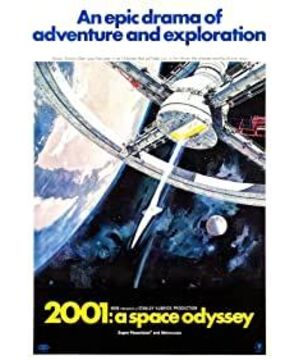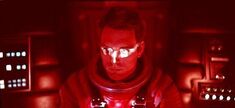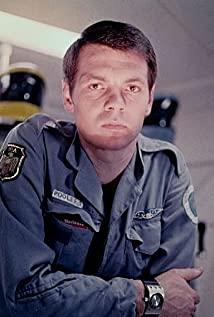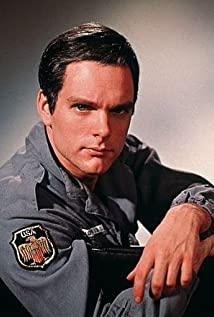The French philosopher Deleuze has such an exposition of "2001: A Space Odyssey" in his film theory work "Time-Image": He believes that the key object in the film-Blackstone, represents three different stages of the brain Sexual state: animals, humans and machines, and the travel of humans in space in the film is essentially an exploration of the brain and state of mind. Before Deleuze, most interpreters linked the film to interstellar exploration and alien civilization, but Deleuze gave another different but equally enlightening idea: "2001: A Space Odyssey" is An analogy/metaphor about the evolution and change of human's own thinking state. In the film, although human civilization continues to evolve, from primitive society to space, from beginning to end, it faces an inherent game with thinking and products. And we can open a door to understand this film.
Dawn of mankind
The first act of the film "The Dawn of Mankind" begins in the prehistoric society, on the primitive plain where human ancestors lived. Obviously, this was at least before humans learned to use tools more than 3 million years ago (two animal skulls with stone cut traces were unearthed in Ethiopia. They are believed to be at least 3.4 million years old, and therefore humans The starting point of time when ancestors used tools was also pushed forward to this stage of prehistory). The film shows us the harsh living environment of the orangutans. They live in caves, live a life without food, and are attacked by beasts. The film deliberately presents a shot of a cheetah attacking an ape from behind, highlighting the survival dangers that prehistoric humans have encountered in the barbaric primitive society: it can come from other beasts, or it can be because of the lack of food and water, and more likely It is the carnage caused by competition for survival among the same kind. How to survive in such a dangerous situation is a difficult problem they face all the time.
In the film, two different tribes clashed for water, and a group of apes suddenly revealed their "secret weapon": animal bones. A member of the opposing team was beaten to death. This unmatched advantage frightened off the adversary, and the water source protected by the apes ensured their own survival.
In the study of prehistoric human history, the use of tools is generally regarded as a great progress in a positive sense. Therefore, the survival of mankind is fully guaranteed, and material civilization can continue to develop. In modern society, many man-made objects-as small as buttons, to mobile phones, car computers, and as large as space shuttles-although they are far apart in terms of technical complexity, they all have some common tool. Furthermore, the use of tools closely depends on the acquisition of human knowledge and experience, as well as the enlightenment and development of human abstract thinking and judgment. The latter was summarized as rationality by the famous German philosopher Kant in the 18th century. .
Kubrick's view of the relationship between humans and tools is obviously different. He deliberately redesigned this scene of human discovery and use of tools in a symbolic way according to his own understanding: the apes living in groups in the cave in the middle of the night suddenly discovered that a black stone with a smooth appearance and regular shape was standing at the entrance of the cave. The unfamiliar object feels extreme fear, and is deeply attracted by it. They gradually approached it from the initial observation from afar, gathered around and tremblingly stretched out their hands to touch it. At this time, a special picture appeared: in the overhead shot, the black stone stands tall, and at the top of it, the corner of the sun. It gradually appeared, releasing a dazzling light. The camera switched to the next scene. An ape was searching aimlessly among the remains of animal bones. Suddenly he picked up a thick animal bone and seemed to realize something. At this time, the shots of Blackstone and the sun briefly flashed again. On the other hand, the orangutan seemed to be inspired, suddenly waving its bones and starting to crush everything around it-it finally discovered that it could use tools to achieve a certain purpose. In the next scene, it held up its bones to defend the water source and killed a member of the opposing tribe in the battle.
The word "Lumière" (Lumière) in French has another important meaning "enlightenment". The Enlightenment that emerged in France in the eighteenth century is exactly the same word in French. In the history of Western civilization, one of the most important achievements of the Enlightenment that originated in France and influenced the whole of Europe was the establishment of the status of "rationality" in the fundamental thinking methodology of science, art, culture, and society. It was under the impetus of rational enlightenment that Western civilization completely surpassed the political and economic system of feudal society and entered the stage of highly developed primitive accumulation of capitalism. The Western civilization that has continued since then has always regarded the Enlightenment as one of the most important ideological sources.
However, the evaluation of the Enlightenment after World War II had different voices. Some of these researchers believe that the barbaric growth of capitalist material civilization brought about by the Enlightenment is the source of imperialism, colonialism and the two world wars. This is the famous reflection on "modernity". In his book "Modernity and the Holocaust", the British sociologist Sigmund Bowman directly connected the German Nazi's Holocaust on the Jews during World War II with the transcendental transcendental status of scientific rationality. He pointed out that it was out of absolute rationality that the Nazis converted the policy of expelling Jews into concentration camp massacres in order to achieve the goal of no Jews in the German-occupied area, simply because it was the best in terms of efficiency and cost accounting. Kubrick was also one of the doubters of the Enlightenment. We can see this from the grafting between the war madman in his film "Doctor Strange Love", the atomic bomb that represented the highest scientific achievement of mankind at that time, and the calm and crazy Nazi thought.
An anecdote about the film version issue may reveal Kubrick’s intentions: After the first screening of "2001", Kubrick made the final changes to the film. He deleted the nineteen minutes of lengthy content, but was The moment the orangutan picked up the animal's bones once again plunged into the picture where the sun's rays above the black stone gradually revealed. Obviously, Kubrick was not satisfied with the intention of the scene in the first edition. The reason why he added the image of "Black Stone and Light" here, he wanted to emphasize the "Enlightenment" and prehistoric humans represented by Black Stone. Learn to use the connection between tools, in other words, what he wants to emphasize is the close connection between the generation of reason and the human desire for survival and development: under the pressure of survival crisis, human beings can only discover and use the light of rationality. Learn to use and develop tools, and thus begin to make confrontational changes to the surrounding environment. Such transformations can be creative discoveries, inventions and innovations, but at the same time they can also be the subsequent killing of the same kind. That bone has not only become a symbol of a tool, but the tool itself has also become a representative of the final result of human material civilization. This is the purpose of the prehistoric human beings throwing animal bones into the air in the film, but turning it into a spacecraft that slowly floats in space a million years later. Reason, tools, and the high-level material civilization eventually developed by mankind have established a coherent and close relationship under this description. The loose beginning chapter that seems to have no plot connection with the film is actually intended to outline the source and process of the development of human material civilization: no matter how earth-shaking changes the human living environment has undergone, its relationship with reason and tools has never been Change.
Blackstone and Howl 9000
The life fragments of prehistoric humans ended in an unusually abrupt way in "2001: A Space Odyssey". Through the image conversion between animal bones and spaceships, the film spans the history of human development that may be as long as millions of years. The era of space travel in which science and technology are super-developed. But as mentioned above, this huge leap in appearance has not changed human beings' reliance on rational thinking and tool practice.
The plot of the film gradually unfolds with a large number of gorgeous to extreme space travel scenes: American scientific researchers discovered an anomalous material of unknown origin in a secret location on the moon, and a team led by Dr. Freud landed on the moon Come to the scene. At this time, we discovered that it was originally the black stone that brought rational enlightenment to mankind in prehistoric times, but it seemed far less “friendly” to mankind than millions of years ago. Instead, it made a sharp, ear-piercing noise that was almost unbearable by the researchers present. . At this time, the film stopped abruptly again and jumped to eighteen months later, the second act "Jupiter Mission" began immediately.
Two astronauts, Dave Bowman and Frank Poole, flew a huge spacecraft "Discovery" to Jupiter, along with three researchers who had entered hibernation. But what is a bit surprising is that the two astronauts who are always awake do not know the real purpose of the trip, and the overall operation of this spacecraft is an advanced artificial intelligence computer, Hal 9000. In fact, in the subsequent development of the plot, we learned that perhaps only Hal can truly understand the true purpose of the Jupiter mission.
The plot of this scene is actually unfolded in the escalating conflict between humans and artificial intelligence. A technical error by Hal made the two astronauts gradually lose confidence in it, and they had the idea of shutting it down. But Hal took the first step to counterattack: Frank lost control of the spacewalk and fell into the universe, while Dave, who was going to rescue, was intercepted by Hal from Discovery. In this confrontation between mankind and the super tool he invented, mankind barely gained the upper hand—Hal was finally shut down completely and lost his ability to think. Contrary to the situation in which tools in prehistoric times helped its users survive in harsh environments, this time artificial intelligence, a tool that represents the highest level of scientific rationality, made by mankind, has become the murderer of mankind.
We may need to introduce some philosophical concepts to understand Kubrick’s expressive intentions. The famous German philosopher Max Weber once put forward two famous concepts "value rationality" and "instrumental rationality". In a simple and popular explanation, value rationality is the ultimate goal determined after thinking, and instrumental rationality is an instrumental means that must be used in order to realize value rationality. The latter encompasses a very wide range. It can be a materialized tool created by mankind, or it can be a path, method, and method chosen to achieve a phased goal. Although physical tools and abstract methods may be different in form of expression, their philosophical meanings are the same, and they are both methods used to achieve a specific purpose.
The philosophers of the Frankfurt School once deeply criticized instrumental rationality and believed that it was closely connected with the spiritual alienation and intellectual exploitation of individual humans carried out by capitalism. In "Modernity and the Holocaust", Sigmund Bowman believed that a social system constructed by strict scientific rationality would lead to the institutionalization of people's thoughts and actions, leading to a strong emphasis on the means (instrumental rationality) of achieving goals. Relying on and completely neglecting to make moral and ethical judgments on them is exactly the foundation and hotbed of the original ideas of the Nazis' mass murder of Jews.
Even today after the end of World War II, there is still no clear judgment on the limits of instrumental rationality. In other words, just as the scene portrayed at the beginning of "2001: A Space Odyssey": under the pressure of the crisis-ridden environment, the strong desire to survive "forces" the apes to survive and produce the initial rationality, through this rational consciousness The role of "enlightenment" Human discovery tools are effective means to achieve this goal. When rationality and tools are combined to form an "instrumental rationality" effect, the first consequence it causes is the death of the same kind.
When the tool exerts its efficiency, human life is threatened. This is what Kubrick consciously presented in the first part of the film. In the second part of the film, the "tool" (Hal 9000) developed by reason has reached the perfect state, almost becoming an entity independent of people's spiritual consciousness, and at the same time the utility is exerted to the extreme. , It also produced a real threat to human life: Frank lost his life for this, and Dave only relied on his amazing courage to reluctantly win the confrontation with Hal. And this scene is actually just a copy of how prehistoric humans used the rudiments of instrumental rationality (animal bones) to kill the same kind a few million years ago.
Why did Hal suddenly turn from a gentle and considerate artificial intelligence into a ruthless murderer? After Dave completely stopped Hal's operation, a pre-recorded speech appeared on the screen, in which Dr. Freud revealed the true purpose of the Jupiter mission: the black stone launch found on the moon eighteen months ago A steady ray was directed at Jupiter, which researchers believe is a sign of extraterrestrial intelligence. The purpose of Discovery’s trip is to go to Jupiter to find out the truth. Dr. Freud also revealed in his speech that only Hal knew the essence of this mission on the Discovery.
At the beginning of the second act, Hal had a conversation with Dave of unclear semantics, in which it took the initiative to bring up the rumors of Blackstone to Dave, calling the fact that it was unearthed on the moon as a rumor, and Show that you don't believe it. Obviously Hal lied here, because Freud's subsequent speech revealed that Hal was an insider. If it is said that in order to follow Dr. Freud's instructions and keep a secret before Discovery reaches Jupiter, it does not need to talk about it to Dave. But the strange thing is that it raised the Blackstone rumors in a negative manner, and at the same time asked Dave his views on the matter in a tentative tone and his understanding of the true intentions of the Jupiter mission. Of course, the alert Dave did not directly answer Hal's spying inquiry.
If we confirm that Blackstone represents the enlightenment of instrumental rationality, then obviously Hal, as the master of instrumental rationality, has a much clearer understanding of the meaning of Blackstone than human beings. Similarly, as an information-gathering terminal, artificial intelligence also understands the suspicion and criticism of instrumental rationality that humans have experienced after the two world wars. Therefore, in the second act of the film, a paradox that makes people feel palpable: out of safety considerations and super trust in tool rationality, the leader of the Jupiter mission temporarily kept the details of Blackstone-related missions secret from the team members. But it is stored in Hal's information system. Since the secret contained in Blackstone is likely to be the ultimate negative judgment of instrumental rationality, Hal's logical system has forced it to produce the concept of "betrayal": if the negative meaning of Blackstone's Enlightenment is fully grasped and understood by humans, then do Will it face a dead end, which is a product of pure instrumental rationality? Just as the murderer hides in the chasing team that goes to apprehend him, all it can do to prevent the truth from being discovered is to delay and destroy Jupiter's mission. In order to achieve this goal, it does not hesitate to cost the lives of astronauts, which is a typical instrumental rational thinking.
Howl began to obstruct the mission process step by step: it first reported a malfunctioning communication component AE-35, forcing the astronauts to get out of the cabin to replace it; then he refused to admit his mistake and made the astronauts right. The reliability and safety of the flight are in worries. Here, there can be two different explanations for the misreporting error of AE-35: According to the novel of the same name published by one of the screenwriters, Arthur Clarke, after the film was released, this is a mistake made by Hal, and it did it. It is the result of the unreliable side of the tool; but in Kubrick’s film, Hal’s report of the error is immediately after his conversation with Dave, we can faintly feel that it is trying to influence Dave’s execution by spreading rumors. The determination of the task, but did not produce results. So it has nothing to do with regeneration, and disrupts the Jupiter mission by reporting the error AE-35. No matter which of these two speculations is closer to Kubrick's original intention, it caused the two astronauts to have a serious distrust of Hal. This directly triggered a thrilling game between the two sides, and the final result was Frank's death and Hal was permanently cut off.
Space capsule and fascist aesthetics
Maybe we can also understand Kubrick's intentions from the set and prop design of the second act. Different from the design of the spaceship capsules in other science fiction movies, the main capsule of Discovery is a ring-shaped enclosed space erected like a ferris wheel. Due to the special gravity design, the astronauts can move from bottom to top or from top to bottom along the circular bulkhead like an acrobat, giving the audience the illusion that the characters are flying in the cabin. The set designers took inspiration from hamsters running in rotating closed pulleys: they created giant circular space capsules that could rotate, in which the actors walked or jogged, but kept in place. Instead, a mechanical device activates the ring-shaped space capsule to rotate in the opposite direction of the astronaut's assumed motion. The camera is fixed on the base of the Ferris wheel and does not rotate with it. So in the viewfinder, we got the visual effect of the astronaut flying over the wall in the cabin.
The design concept of the artificial intelligence Hal 9000 is also revolutionary. Science fiction movies before "2001" were used to give human-created robots or intelligent people a concrete appearance. But Kubrick broke this mindset. He only left Hal with a red light to represent its "eyes", and it does not have other physical existence, more like a complete "artificial consciousness". "We can feel its existence everywhere in the cabin of Discovery.
With such a huge amount of manpower and material resources, Kubrick actually built a completely enclosed space. Although it sails in the vast universe, it is actually isolated from the outside world. To borrow Deleuze's metaphor, this space is more like the human brain in modern life than a spaceship. It is divided into two parts, a mixture of normal perceptual consciousness and rational consciousness (people), and an instrumental rational consciousness (Hal 9000) that can think and act independently and think that it is omnipotent and infallible. It is between these two that a life-and-death contest has begun. What is left for us to think about is, what is the nature of such a contest? Is it just a coincidence, a confrontation surrounding survival, or does it have a deeper metaphorical connotation?
Susan Sontag, who has extraordinary insight into cultural phenomena and the ideological direction behind it, mentioned in her article "Fascinating" Fascism that the overall aesthetic effect of "2001" is permeated with a fascist art form And theme ideas. The luxurious and magnificent picture of the universe, the neat and spotless interior decoration of the space base, the characters' simple and military-style clothing, meticulous and emotionless speech and expressions (even the conversations between the astronauts and their families are regular In the emotional program of the astronaut-please pay special attention to astronaut Frank’s indifferent and indifferent expression when receiving the family’s birthday greeting video message), grand, restrained, and full of Germanic gorgeous and emotional music, coordinated in space The giant spaceship sailing silently in the middle of the world, all of this has created a flawless and almost perfect artificial space world. In Sontag's words, one of the characteristics of fascist aesthetics is to create a perfect external form, and in the first half of "2001", what Kubrick deliberately creates is such a utopian perfect future world. In it, we don’t experience the emotional expression and personal emotional portrayal of people as individuals. Everything is covered in a structured and completeness. Even birthday blessings and family greetings have been branded with a regular and procedural imprint, which makes people I feel that the private nature of family and relatives’ communication has given way to its social constitutional attributes as a component of the system.
However, what is the overall aesthetic intention of designing "2001" with a sense of "fascism"? In Kubrick's last work "Dr. Strange Love", an accidental madness opened the door to a full-scale nuclear war between the Soviet Union and the United States in the Cold War confrontation. And when the world was facing a crisis of destruction, the Nazi factors hidden in the capitalist system suddenly appeared in a purely rational way: Dr. Qi Ai with a strong German accent could not suppress the Nazis and raise his hands to the President of the United States. The aides peddled a complete set of Nazi political system, sociology and superior race consciousness, and said that in the crisis of nuclear bomb destroying the world, this is the most rational surviving plan. Just as Sigmund Bowman described the relationship between reason and the Holocaust, what "Doctor Strange Love" revealed to the audience at the end is that the crisis awakens the huge possibility of Nazi and fascist factors hidden in the social system. In "2001", prehistoric humans discovered and learned to use tools to slaughter opponents when facing survival crisis, which is almost the prototype of the close connection between reason and slaughter.
When Sigmund Baumann described his analysis of the production mechanism of the Holocaust, he believed that although Nazi Germany failed in World War II, the rational thinking and logical mode of judgment that gave birth to Nazism and the destruction of mankind in Western civilization has never changed. . In other words, the progress of society, the development of science and technology, and the advancement of human civilization have not changed its inherent tendency to slide toward the "holocaust." On the contrary, we rely more on such a single instrumental rational model than in the past to expand and accelerate the creation of material civilization. It is at this point that "Dr. Strange Love" and "2001" have found the same expression in the core: when prehistoric humans took up tools to slaughter the same kind to satisfy their desire for survival, humans opened up a single instrumental rationality. Dominate the road. Although it has developed material civilization to an unimaginable height after millions of years, mankind itself has not escaped the fate of being destroyed in the collision of contradictory desires. The massacre of Jews by Nazi Germany in World War II was already an extreme example of instrumental rationality of evil. (Bauman believes that the Nazi slaughter of Jews was not out of hatred or hostility, but was based on the "first" that caused the Jews to disappear from German-occupied territories. The efficiency principle of instrumental rationality under the guidance of the “experimental goal”—that is, genocide is the most efficient tool to achieve this goal), and as Sigmund Bowman analyzed, without deep reflection on it, No one can prevent it from losing control a second time and causing disaster.
It is at this level that we returned to the cabin of the Discovery and witnessed a conflict between human beings and Hal 9000, the essence of its rational development. Without realizing the dark side of instrumental rationality, human beings fell into the killing trap set by it, and the survivor Dave finally cut off the instrumental rationality Hal 9000 after a hard fight. But while destroying his opponent, he also fell into a kind of rational madness: the cold expression he showed when he walked into the cabin where the oxygen was emptied to cut off Hal, and he was indifferent to Hal's fading children's songs. Carrying out the task of cutting it off all shows that human beings are actually in an endless loop-in order to eliminate the opponent (even if it is a representative of instrumental rationality), we can only be more calm, rational and instrumental than it. And following this path, what is unfolded before Dave (that is, human beings) is a confused, perplexed and unintelligible universe.
Human rebirth
After cutting off Hal, Dave discovered the video message left by Freud and learned of the existence of Blackstone. In the dialogue with Hal, the latter once said: "This mission is so important to me, I don't allow you to destroy it." Dave realizes that Dohal's "betrayal" is closely related to the secret carried by Blackstone. In order to thoroughly clarify these doubts, he embarked on an interstellar journey alone. And this opened the third act of the film "Jupiter and Beyond Infinity".
At the beginning of this scene, Discovery has arrived in the outer space around Jupiter, and a huge black stone lay across the universe. And Dave approached Blackstone in a small exploratory vehicle. In the process, it passed through dazzling nebulae and vast deserted canyons, and finally stopped in a surprisingly Louis XVI style suite.
It should be said that from the journey through the nebula, "2001" has completely got rid of the shackles of linear narrative, and entered the ideographic stage by borrowing the form of experimental film. And we can also understand it as Dave died in the process of traveling through the nebula. And what is shown at the end of the film is likely to be the hallucinations he had before dying. What it represents is Dave's intuitive projection of Blackstone and the secret it represents.
In the book Kubrick written by French film theorist Michel Simão, it was specifically mentioned that Kubrick believed that many problems of human civilization originated in the eighteenth century. The room in which Dave was in the illusion happened to be in the era of Louis XVI, the last French king in the 18th century, and this was the time and place where the Enlightenment began and flourished. Here, Dave is no longer the astronaut driving the Discovery, but a symbol of mankind. He spent the rest of his life in fragments and jumps, and for the rest of the time he was always imprisoned in the luxurious room of "enlightenment". Before he died, it was the symbolic black stone that he had to face. In Kubrick's view, it is it that troubles the destiny of mankind, or in other words, the instrumental reason it symbolizes dominates mankind. We are aware of its dark side, but at the same time we cannot get rid of our dependence on it. Where is the way out?
At the end of the film, the dead Dave turns into the mother of the star child looking down on humanity in space-the earth. It implies that Kubrick answered with his own assumptions: only when human beings are reborn and start a new evolutionary path with completely different ideas, can they get rid of the dominance and slavery of instrumental rationality to human beings. The film ends this huge and complicated space fable with inexplicable hope in such a pure hypothesis.
It should be mentioned that the idea of Blackstone in "2001" comes from the short story "Sentinel" by the famous science fiction writer Arthur Clark. Alien wisdom left a pyramid-like building on the moon as a guardian sign to mark the earth as a planet suitable for the reproduction and development of life. The script of "2001" was co-written by Arthur Clarke and Kubrick. The latter borrowed a lot of Clark’s conceptual ideas and related popular science knowledge in previous works, but the two produced a lot of the main theme of the film. The differences, cooperation has not been smooth sailing. After the film was released, Arthur Clarke published a novel of the same name, but the treatment of key plots in it was different from the film directed by Kubrick.
In the novel, the call of the alien wisdom to the earth becomes the main theme, and the conceptual treatment of Blackstone is similar to the "Sentinel", only as a sign of the enlightenment of the alien wisdom to mankind. The three different parts, prehistoric humans, the interstellar journey of Discovery, and Dave's illusion in the mysterious room are barely connected by the black stone, which symbolizes extraterrestrial wisdom, and there is no deeper logical connection inside. But in Kubrick’s film, just because Black Stone represents the dark side of the instrumental rational enlightenment that humans have received, every appearance of it is closely integrated with the internal logic of the plot: the first time it was a prehistoric period for humans. The enlightenment of reason, the second time was a foreshadowing of the crisis facing mankind on the moon (represented by the subsequent conflict between Hal and the astronaut), and the third time was the discovery of mankind in space near Jupiter The real dilemma that appeared in the eighteenth-century-style suite in Dave’s illusion for the fourth time heralded the end of the road of human development, and at the same time revealed that human beings can only get rid of the curse of Blackstone by taking a new path after rebirth. It is in this sense that the meaning of Blackstone closely corresponds to the role of instrumental rationality in the history of human development in "2001", forming a solid overall work.
Similarly, in dealing with many details, Clarke's novel only provides a sketch and explanation, but does not allow it to establish a corresponding connection with the whole of the work. For example, for the rebellion of Hal 9000, Clark only described it as a contradictory consequence between a computer and a human caused by a mistake, and did not involve the relationship between the human and instrumental rationality that Kubrick intended to refer to. conflict. Therefore, although Clark’s novels and Kubrick’s films have the same narrative structure and some storylines, they are two different works in terms of the core theme of the intention: Clark’s focus on the mysterious alien wisdom for humans While Kubrick intends to highlight the paradoxical conflict between human consciousness and instrumental reason that cannot be reconciled, extraterrestrial wisdom retreats to a causal story line. However, due to the multiple metaphorical expressions of "2001" and Kubrick's refusal to provide a clear textual explanation after the film was released, viewers and commentators had to resort to Clark's novels as a last resort. Understand Kubrick's intentions, and this caused a lot of misinterpretation of the film.
We can also examine "2001: A Space Odyssey" in the wholeness of Kubrick's series of works.
Throughout Kubrick’s career as a director, although each of his films involves a different genre, they have always revolved around the themes of desire, reason, system, and madness, and planted the main themes (except for " "Spartacus" (1960) was filmed without complete control, and Kubrick was reluctant to admit that it was his own work), forming an overall expression that lasted for nearly 30 years: "Glory "The Road" (1957) is about the devouring of innocent individuals by a rational system controlled by personal ambitions; "Lolita" (1962) outlines Saki love who is dominated by desire and loses self-control; "Doctor Strange Love" (1964) ) Is directly involved in the subtle and complex connection between institutionalized rationality, war madness, and Nazism; A Clockwork Orange (1971) is a contradiction between extreme indulgence and strict rationality, and Barry Linden (1975) Returned to the eighteenth century, where Kubrick was most interested, to explore the decline of a dude at the arrival of the age of reason; The Shining (1980) once again reconstructed the form of the space-brain, which made the individual crazy and closed. The ideology and memory in the space are connected; "All Metal Shell" (1987) shows the process of the death of individual consciousness and transformed into a tool; and "Open Eyes" (1999) explores rational madness based on the marriage system The ultimate relationship with human desires. "2001: A Space Odyssey" in the middle of Kubrick's creative career is a gorgeous explosion of all these thought expressions: it breaks through the conventions of feature films with a narrative without a protagonist that seemed extremely special at the time. The in-depth philosophical thinking about human reason and desire turned into a magnificent space fable, and at the same time, it updated the form of the film with avant-garde and close to experimental film techniques.
From the perspective of the artistic and ideological value of the film, the serious and ultimate propositions involved in "2001: A Space Odyssey" were even negligible or even difficult to understand in the humanities at that time. Therefore, it is at the forefront of the history of human thought; and From the perspective of the film industry, the success of "2001: A Space Odyssey" is a challenge to Hollywood's mainstream commercial film system. It drove Hollywood to bid farewell to the "classic film" consciousness of the old age, and gradually turned to content full of post-modernity. Open your mind and expression.
View more about 2001: A Space Odyssey reviews











